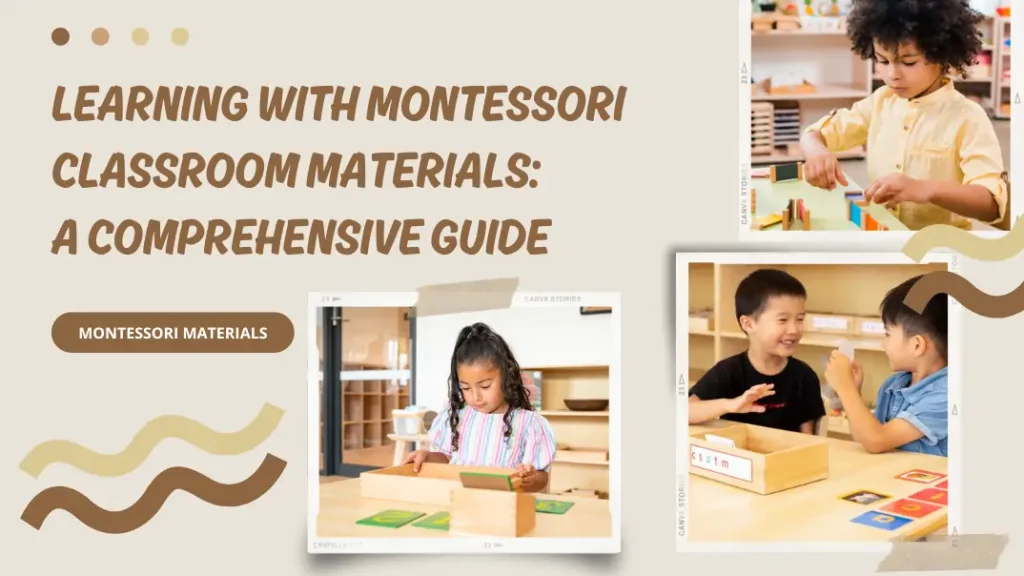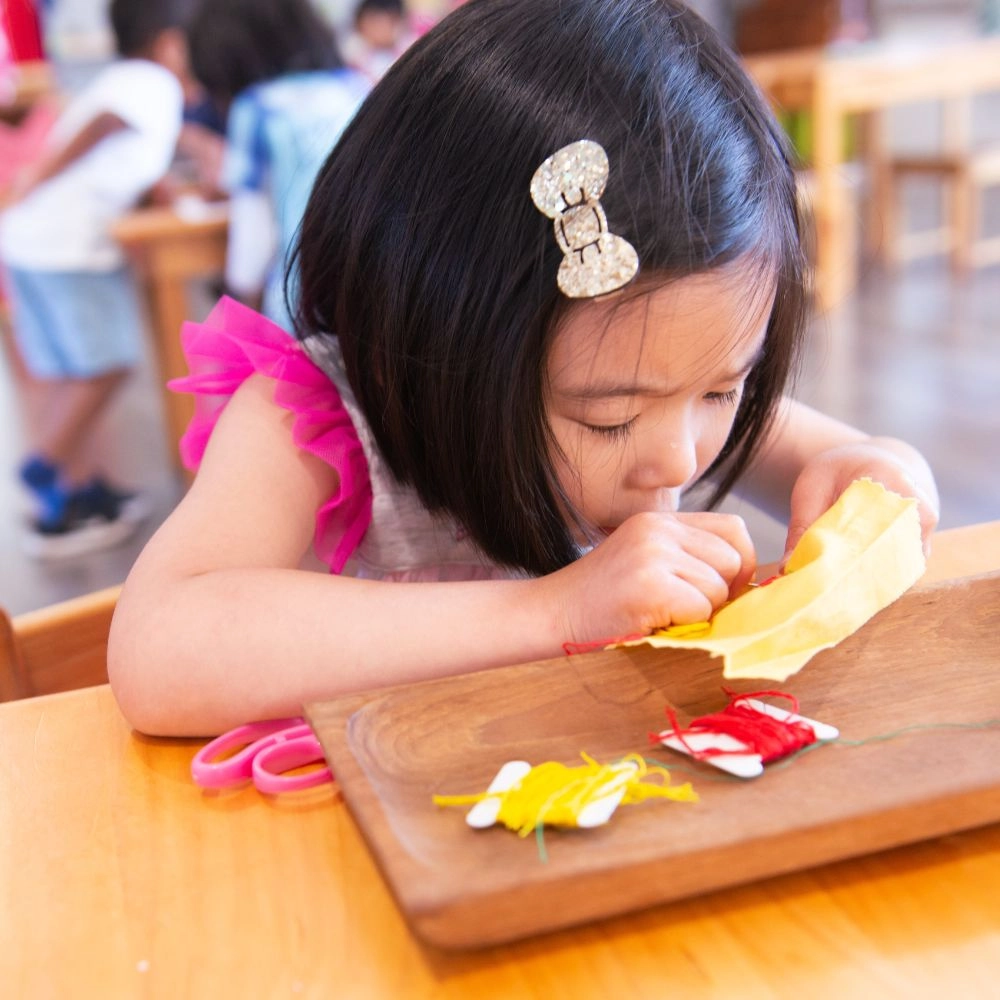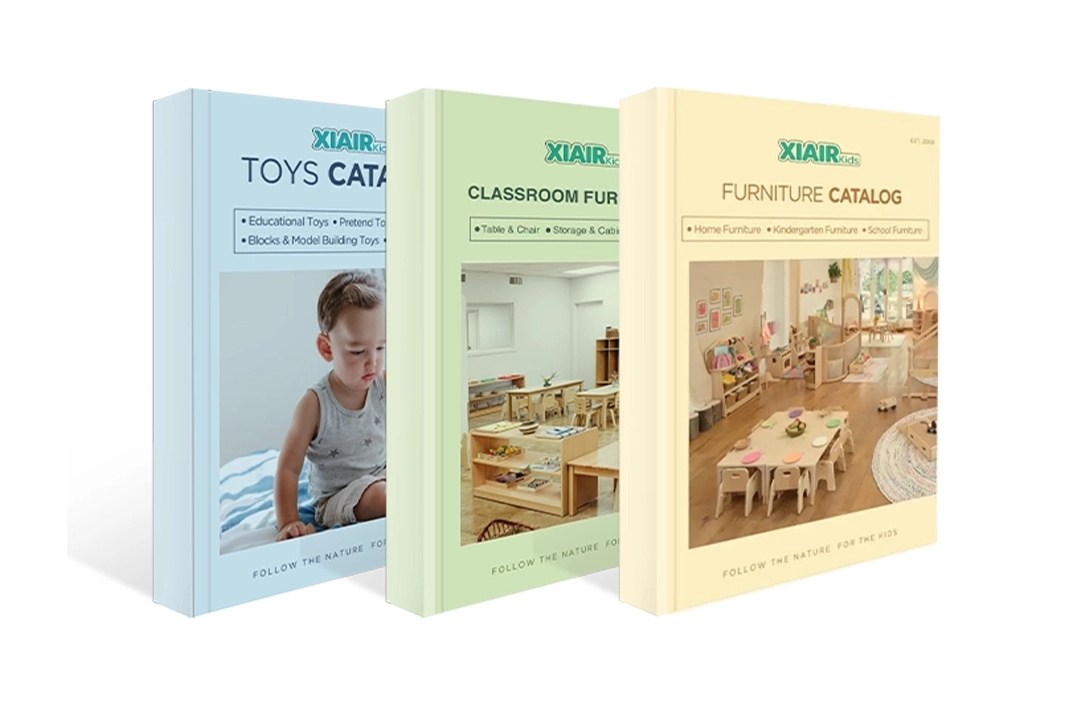Are you struggling to find classroom materials that truly help children explore, think, and grow on their own? Are the tools in your classroom more about keeping kids busy than actually helping them learn?
In many early childhood classrooms today, learning feels forced. Children are expected to sit still, memorize facts, and follow instructions — even when it goes against how they naturally learn. Traditional teaching tools often limit creativity and curiosity. As a result, kids lose interest, educators get frustrated, and the learning doesn’t stick.
That’s why Montessori classroom materials have become a game-changer. These tools are designed to support how children learn through hands-on discovery, movement, and independent thinking. In this article, we’ll break down what these materials are, how they work, and how to use them in your classroom to create a more focused, joyful, and adequate learning space.
Introduction
Montessori classroom materials are the heart of every well-designed Montessori space. They’re not just beautiful or natural — they’re made to help children build fundamental skills by using their hands and their minds together.
Whether you’re starting a new classroom or updating your materials, this guide will walk you through what to use, how to use it, and how to choose the right sets for different ages. If you’re looking for materials that spark curiosity, support independence, and work, you’re in the right place.
What Are Montessori Classroom Materials?
Montessori classroom materials are at the core of every Montessori learning space. But they’re much more than just teaching tools — they’re carefully crafted experiences. Each one is made to guide children toward independence, focus, and discovery. In this section, we’ll look at what these materials are, where they come from, and what makes them so different from traditional classroom tools.
Definition and Origin
Montessori classroom materials are hands-on educational tools that help children learn through active exploration. First developed by Dr. Maria Montessori, these materials are designed to support how children naturally absorb information by touching, repeating, and discovering for themselves.
Rather than delivering information through lectures or worksheets, Montessori materials invite children to engage with concepts like size, quantity, sound, texture, language, and order in a way that’s both tactile and intuitive.
Each material focuses on one specific skill or concept, allowing children to work independently and learn at their own pace. This simplicity, paired with intentional design, is what makes these materials so powerful in supporting early childhood development.
Maria Montessori’s Design Philosophy
Dr. Maria Montessori believed children learn best in a prepared environment that allows them to act freely within clear boundaries. Her materials reflect this idea: they are structured but not limiting, beautiful but purposeful, and always made with the child’s experience in mind.
Some of the key design principles include:
- Isolation of difficulty – Each material targets just one skill
- Control of error – Children can spot and fix mistakes independently
- Hands-on experience – Children manipulate, move, and explore physically
- Progressive complexity – Materials build upon each other in a logical sequence
- Real materials – Items are made of wood, glass, metal, and cloth to provide real-world texture, weight, and temperature
This thoughtful approach is why Maria Montessori classroom materials continue to be used over a century later in schools worldwide.
Montessori vs. Traditional Classroom Materials
To help you clearly understand the difference between Montessori and traditional tools, here’s a quick comparison:
| Aspect | Montessori Classroom Materials | Traditional Classroom Materials |
|---|---|---|
| Learning Approach | Self-directed, hands-on exploration | Teacher-led instruction |
| Material Purpose | One skill per material, concept-focused | Often multifunctional or theme-based |
| Error Correction | Built-in control of error | External correction by teachers |
| Material Design | Natural, realistic, tactile materials | Synthetic, often plastic and decorative |
| Child Role | Active participant in learning | Passive receiver of information |
| Use of Movement | Movement is encouraged and purposeful | Movement is often restricted |
This side-by-side view highlights how Montessori materials are not just different in form, but in philosophy and function as well.
What’s Unique About Montessori Materials?
There are many educational products on the market, but Montessori classroom materials stand apart in powerful ways. Here’s what makes them truly unique:
- They teach one thing at a time
Each material is designed to isolate a single concept — like color gradients, size, or sound — so children can focus and master it. - They are self-teaching
Children don’t need constant guidance. With built-in error control, they can correct themselves and build independence. - They match how children learn naturally
Through repetition, touch, movement, and exploration, children can go deep into each material at their rhythm. - They support all learning styles
Visual, auditory, and kinesthetic learners all benefit. Montessori materials engage multiple senses at once. - They are made from real materials
Children work with tools that feel real: glass, wood, metal. This builds care, responsibility, and connection to the real world. - They progress in order
Materials are arranged on shelves from simple to complex. Children move forward only when ready, building strong foundations.
In short, Montessori classroom materials don’t just teach facts — they build minds, habits, and confidence. They’re not just tools — they’re stepping stones toward independence and lifelong learning.
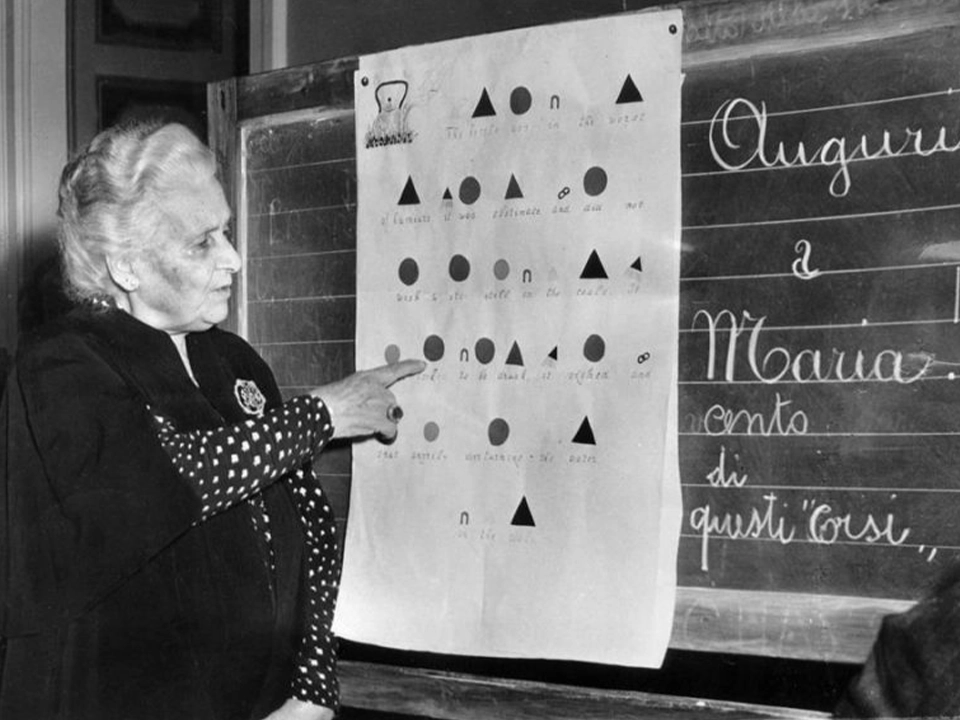
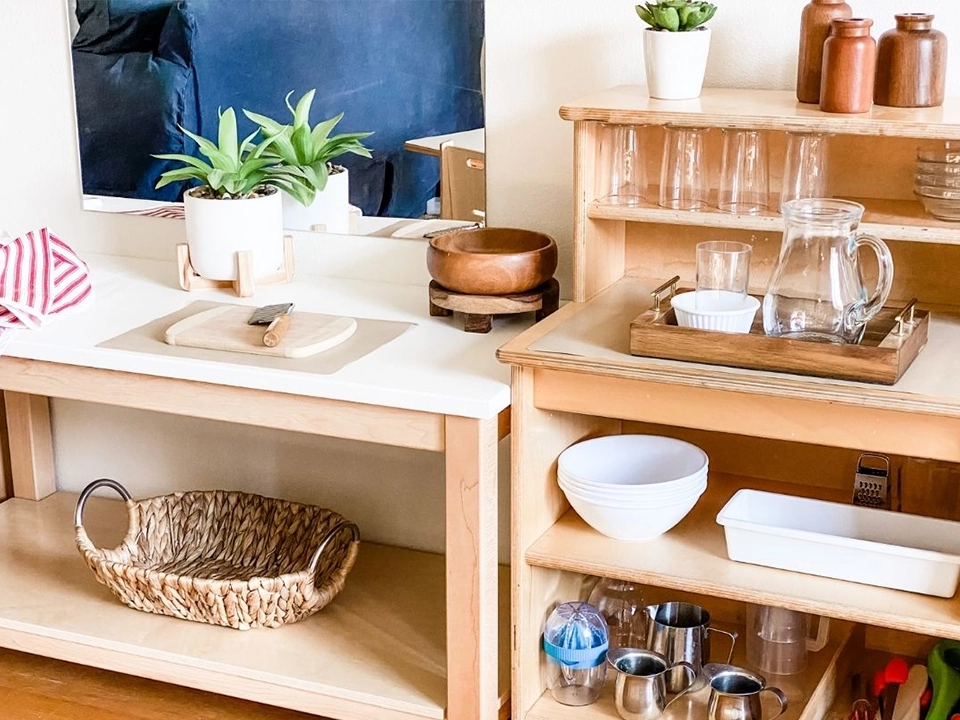

How Montessori Materials Support Child Development
Montessori classroom materials aren’t just teaching aids — they are active tools in shaping the whole child. Each one is thoughtfully designed to nurture specific areas of development, from fine motor skills to emotional growth. But beyond isolated skills, these materials work together to build independence, focus, and a lifelong love for learning.
In this section, we’ll explore how these materials support the child across multiple dimensions — intellectually, physically, emotionally, and socially.
Independence and Self-Motivation
One of the most important goals of Montessori education is to help children become confident, self-directed learners. Montessori classroom materials are specifically designed to encourage this by giving children the freedom to choose, explore, and repeat activities without constant adult intervention.
Each material is presented in a way that lets the child take charge. For example, pouring water from a minor pitcher, buttoning frames, or matching geometric shapes requires concentration and focus, but also grants the child complete control of the process. As they succeed, children experience genuine achievement, which builds intrinsic motivation.
Because children can repeat activities as often as they like, they naturally develop perseverance. They work not to please the teacher but because they are drawn to the task itself. This sense of ownership is foundational for lifelong learning.
Concentration and Order
Montessori classroom materials are placed on open, accessible shelves, always in the same spot, and always in order, from simple to complex. This physical layout mirrors the mental structure that Montessori education builds within the child: a love for order, logic, and step-by-step progression.
Materials are introduced one at a time, with great care and simplicity. This creates a clear mental image for the child to follow. Over time, children become intensely focused, even in a room filled with other children, not because they’re told to “pay attention,” but because the materials draw their attention naturally.
This ability to concentrate and follow logical steps supports academic learning and executive function, a critical life skill.
Fine Motor and Sensory Refinement
Whether it’s threading beads, transferring beans with tongs, or matching textured fabrics, Montessori classroom materials involve precise hand movements. These activities are enjoyable but also serve a deeper purpose: they train the child’s hands, eyes, and muscles to work together with accuracy and grace.
Fine motor skill development isn’t just about writing later on. It’s tied to brain development, independence, and coordination. A child who learns to pour water without spilling gains not just a skill, but also confidence in their ability to handle fundamental tasks.
Sensory materials, like sound cylinders or color tablets, sharpen the senses one at a time. Each sensorial material in the Montessori classroom is designed to isolate a specific quality — sound, size, texture, weight, or temperature — helping children become more aware of their environment.
This sensory refinement improves memory, language, and even math skills. For instance, sorting objects by length or thickness lays the groundwork for measuring and comparing later on.
Critical Thinking Through Self-Correction
Another powerful element of Montessori classroom materials is that they promote problem-solving from the very beginning. Materials are built with control of error, so children can tell for themselves when something isn’t right, and then fix it.
This teaches children to think, not just follow. If a cylinder doesn’t fit, if puzzle pieces don’t align, or if counting beads doesn’t end correctly, the child sees the problem, pauses, and tries again. They don’t wait for the teacher’s judgment; they become their guide.
Over time, this builds real critical thinking skills. Children learn to observe, reflect, test, and adjust — habits that serve them not only in school but in everyday life.

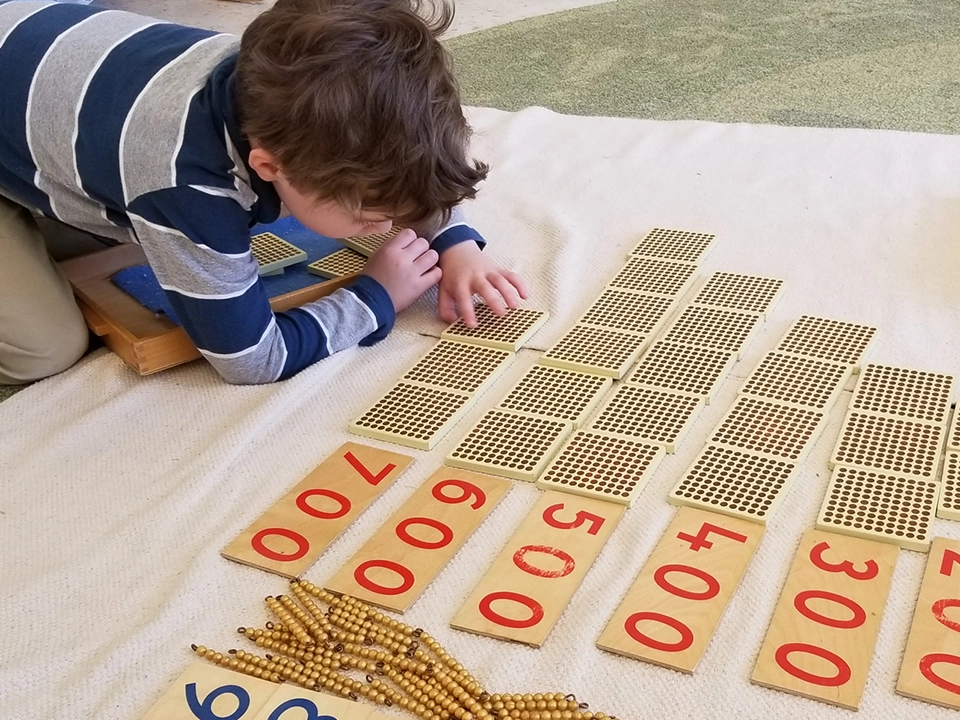
Types of Montessori Classroom Materials
Montessori classroom materials are more than just tools — they’re the building blocks of a prepared environment. Each set is designed to support a specific domain of development and build skills step-by-step. Below is a deep dive into the core material categories and the particular tools within each that every Montessori classroom needs.
Practical Life Materials
Practical Life materials are the cornerstone of every Montessori classroom, forming the child’s very first interaction with structured learning. Though simple in appearance, these tools carry profound developmental value. They are based on real-world tasks and designed to foster independence, order, concentration, and coordination — all of which are prerequisites for later academic success.
This area of the classroom is where children first build confidence in their abilities. From pouring water to buttoning a shirt, they engage in purposeful activities that develop motor skills, logical sequencing, and self-control. These materials also nurture emotional development by giving children a sense of responsibility and belonging. They’re not pretending — they’re doing honest work with fundamental tools, which makes the experience deeply satisfying and motivating.
For educators and caregivers, the Practical Life shelf sets the tone for the entire learning environment. It’s a space where Montessori philosophy comes to life, showing how children can be trusted, capable, and self-motivated when given the right tools.
Preliminary Exercises
- Pouring Activities: Using various pitchers and funnels to pour liquids and solids.
- Transferring Exercises: Utilizing spoons, tongs, or tweezers to transfer items like beans or beads.
- Opening and Closing Containers: Engaging with jars, boxes, and bottles to develop fine motor skills.
Care of Self
- Dressing Frames: Practicing buttoning, zipping, snapping, lacing, and buckling.
- Handwashing Stations: Learning proper hand hygiene through step-by-step processes.
- Shoe Polishing Kits: Teaching children to care for their belongings.
Care of the Environment
- Cleaning Tools: Child-sized brooms, mops, dustpans, and cloths for maintaining the classroom.
- Plant Care: Watering cans and spray bottles for nurturing plants.
- Table Washing Sets: Materials for cleaning tables and surfaces.
Grace and Courtesy
- Role-Playing Scenarios: Practicing polite greetings, offering help, and expressing gratitude.
- Social Interaction Games: Activities that promote sharing, turn-taking, and respectful communication.



Sensorial Materials
Sensorial materials help children make sense of the world around them by refining their five senses and cognitive perception. These tools isolate one specific quality — such as color, texture, shape, size, weight, or sound — allowing the child to study each element in depth and compare, categorize, and name them with confidence.
In the Montessori method, sensory development is seen as a direct pathway to intellectual growth. By working with the sensorial materials in a Montessori classroom, children sharpen their ability to observe, reason, and form concepts. They are learning to think, not just to respond.
From stacking cubes in perfect sequence to matching scent bottles by smell, each material builds neural connections that later support reading, writing, math, and scientific thinking. This isn’t just play — it’s hands-on cognitive training. And because each tool is designed with built-in control of error, children also develop self-assessment and problem-solving skills along the way.
Visual Discrimination
- Pink Tower: Ten pink cubes of varying sizes to teach size gradation.
- Brown Stair: Ten brown prisms differing in thickness to understand dimensions.
- Color Tablets: Boxes containing tablets to teach color recognition and grading.
Tactile Sense
- Rough and Smooth Boards: Exploring different textures to develop touch sensitivity.
- Fabric Boxes: Matching fabrics with varying textures to enhance tactile discrimination.
Auditory Sense
- Sound Cylinders: Pairs of cylinders that produce different sounds when shaken.
- Montessori Bells: A set of bells tuned to the musical scale for pitch recognition.
Olfactory and Gustatory Senses
- Smelling Bottles: Identifying various scents to refine the sense of smell.
- Tasting Activities: Sampling different flavors to develop the sense of taste.
Stereognostic Sense
- Mystery Bag: Identifying objects by touch alone to enhance spatial awareness.



Mathematics Materials
Montessori math materials transform numbers from abstract symbols into tangible, meaningful experiences. Children don’t just learn that 2 + 2 = 4 — they can see it, touch it, and build it. By introducing math concepts through hands-on work, these materials eliminate confusion and make learning both logical and joyful.
Each material follows a precise sequence — from basic quantity recognition with number rods to the complexities of the decimal system with golden beads. Children physically manipulate objects to understand operations like addition, subtraction, multiplication, and division before they ever pick up a pencil. This kinesthetic approach ensures a deep internalization of concepts and helps prevent math anxiety later on.
Montessori classrooms also introduce geometry and fractions through puzzles, insets, and bead chains, laying a strong foundation for future academic achievement. Whether you’re planning your first math shelf or upgrading your Montessori materials classroom package, this area deserves thoughtful attention and variety.
Numeration and Counting
- Number Rods: Introducing numbers and their quantities.
- Sandpaper Numbers: Teaching number symbols through tactile tracing.
- Spindle Boxes: Associating quantities with numerals.
Decimal System
- Golden Beads: Representing units, tens, hundreds, and thousands for place value understanding.
- Decimal Cards: Visual aids for learning the decimal system.
Operations
- Stamp Game: Practicing addition, subtraction, multiplication, and division.
- Bead Frames: Visualizing mathematical operations and place value.
Fractions and Geometry
- Fraction Insets: Understanding parts of a whole through fraction circles.
- Geometric Solids: Exploring three-dimensional shapes to grasp geometric concepts.


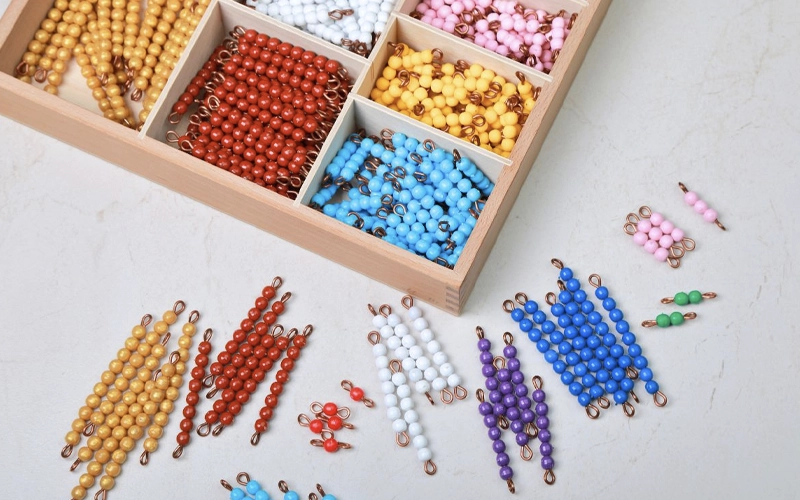
Language Materials
In a Montessori setting, language development is a rich, multi-step process that begins long before a child can read or write. It starts with phonemic awareness and oral language, then moves gradually through writing, reading, and grammar — all supported by beautifully designed Montessori classroom materials that make language learning tactile and enjoyable.
Children first use sandpaper letters to connect sounds with shapes, then begin forming words with a movable alphabet. From there, they transition into reading real words, phrases, and stories, all at their own pace. Writing emerges naturally — often even before reading — because the child has already internalized the sounds and movements needed to form words.
Montessori also introduces grammar at an early age, using intuitive symbols and sentence-building tools that teach sentence structure and parts of speech in a visual, memorable way. Unlike traditional classrooms, where grammar is often abstract and dull, here it becomes something children enjoy.
Language materials don’t just teach literacy — they empower children to express themselves and connect with the world around them.
Pre-Reading Skills
- Sound Games: Enhancing phonemic awareness through auditory discrimination.
- Sandpaper Letters: Associating sounds with letter symbols via tactile tracing.
Writing Preparation
- Metal Insets: Developing pencil control and hand strength for writing.
- Movable Alphabet: Constructing words and sentences to reinforce spelling and grammar.
Reading Development
- Phonetic Object Boxes: Matching objects with corresponding phonetic words.
- Reading Cards: Progressing from simple to complex words and sentences.
Grammar and Syntax
- Grammar Symbols: Visual representations of parts of speech to understand sentence structure.
- Sentence Analysis Materials: Breaking down sentences to comprehend grammatical components.


Cultural Materials
Cultural materials in a Montessori classroom open the door to the broader world. These materials expose children to geography, science, history, art, and music, helping them understand not just facts, but the interconnectedness of people, places, and life on Earth. Through hands-on exploration and observation, children begin to see themselves as part of a larger human family and natural environment.
Unlike traditional methods that rely heavily on textbooks and rote memorization, Montessori cultural materials are designed to be tactile, visual, and interactive. They awaken curiosity, inspire wonder, and nurture respect for diversity. Whether it’s placing a puzzle piece of Africa on a map, classifying leaves, or matching animal types to continents, these activities form deep, lasting impressions that go beyond surface learning.
In the Montessori philosophy, this area is not an “extra” — it’s essential. By giving children the tools to explore physical geography, biological classification, world cultures, and historical timelines, we help them build a sense of identity and global responsibility. These materials also lay the foundation for advanced academic disciplines in later years, from environmental science to social studies and beyond.
Geography
- Puzzle Maps: Learning about continents, countries, and their locations.
- Land and Water Forms: Understanding physical geography through models of lakes, islands, peninsulas, and more.
Science
- Botany Puzzles: Exploring parts of plants and their functions.
- Zoology Puzzles: Studying various animal species and their characteristics.
History
- Timelines: Visualizing historical events and personal milestones.
- Calendars: Understanding the passage of time and significant dates.
Art and Music
- Art Materials: Engaging in creative expression through various media.
- Musical Instruments: Exploring sounds and rhythms to develop auditory skills.



Montessori Classroom Materials Checklist
To assist in setting up a comprehensive Montessori classroom, here’s a consolidated checklist:
| Category | Essential Materials |
|---|---|
| Practical Life | Pouring sets, dressing frames, cleaning tools, plant care materials |
| Sensorial | Pink tower, brown stair, color tablets, sound cylinders, geometric solids |
| Mathematics | Number rods, golden beads, stamp game, fraction insets, bead frames |
| Language | Sandpaper letters, movable alphabet, phonetic object boxes, grammar symbols |
| Cultural | Puzzle maps, land and water forms, botany and zoology puzzles, timelines |
This comprehensive guide ensures that educators and suppliers have a clear understanding of the essential Montessori classroom materials required to create an enriching learning environment.
Your perfect classroom is one click away!
Choosing the Right Materials for Different Age Groups
Montessori education is carefully tailored to the developmental stages of childhood. As such, choosing the right Montessori classroom materials means selecting tools that match a child’s current abilities while gently challenging them toward the next level of growth.
In this section, we’ll look at how to align materials with the sensitive periods of development, divided by common Montessori age groupings. Each stage calls for its approach, and the right materials can make all the difference.
Montessori Materials for Ages 0–3 (Infant and Toddler Stage)
During this phase, children are in what Dr. Maria Montessori called the “unconscious absorbent mind” stage. They learn by watching, touching, and imitating the world around them. Materials at this stage are simple but highly sensory, designed to promote gross and fine motor development, object permanence, and cause-and-effect understanding.

Ideal Montessori materials for 0–3 years:
- Object permanence boxes
- Interlocking discs
- Ring stackers and shape sorters
- Wooden rattles and clutching toys
- Nesting and stacking cups
- Soft dressing frames (simple fasteners)
- Posting activities with different hole sizes
- Sensory bottles and texture boards
- First puzzles (single-shape or knobbed)
These materials support independence and concentration while laying the groundwork for more complex learning later on.
Montessori Materials for Ages 3–6 (Casa dei Bambini / Preschool)
This is a peak learning window — the “conscious absorbent mind” phase. Children in this group are ready for structured exploration of practical life, sensorial input, language, math, and culture. It’s the most materials-rich stage in the Montessori environment.
Core Montessori classroom materials for 3–6 years:
- Dressing frames (zippers, buttons, snaps)
- Pink Tower, Brown Stair, Knobbed Cylinders
- Sandpaper letters and numbers
- Movable alphabet and phonetic objects
- Golden Bead Materials
- Bead chains (short and long)
- Puzzle maps and land/water forms
- Botany and zoology puzzles
- Food prep tools and pouring activities
- Metal insets for writing
This is also the stage where children develop a strong sense of order and love for repetition. Having a full range of carefully sequenced materials is crucial.

Montessori Materials for Ages 6–9 (Lower Elementary)
Now, children are entering the reasoning mind phase — they crave answers, logic, and understanding of the “why” behind things. Materials now need to offer abstract concepts, advanced operations, and deeper subject integration across disciplines.

Best Montessori materials for 6–9 years:
- Stamp Game and Bead Frame for complex math
- Grammar symbol boxes and sentence analysis tools
- Advanced maps (political, physical)
- Fraction circles and geometry sticks
- Timeline of Life, Fundamental Needs charts
- Simple machines and basic physics kits
- Research cards and science experiment trays
- Reading comprehension and classification cards
Materials at this age expand children’s worldview and offer new levels of challenge. Many lessons now bridge hands-on work with writing, reading, and collaborative projects.
Montessori Classroom Materials by Age Group (Quick Reference Table)
| Age Group | Developmental Focus | Recommended Materials |
|---|---|---|
| 0–3 Years (Infant/Toddler) | Sensorial exploration, motor development, object permanence | Object permanence box, interlocking discs, stacking cups, simple puzzles, wooden rattles, sensory bottles, posting boxes |
| 3–6 Years (Preschool / Casa) | Practical life skills, sensory refinement, early literacy and numeracy | Dressing frames, Pink Tower, Brown Stair, sandpaper letters/numbers, movable alphabet, bead chains, golden bead set, puzzle maps, food prep sets, metal insets |
| 6–9 Years (Lower Elementary) | Abstract reasoning, grammar, advanced math, cultural knowledge | Stamp Game, Bead Frame, fraction circles, grammar boxes, sentence analysis tools, political maps, botany charts, zoology puzzles, timelines, science kits |
This table can serve as a Montessori classroom materials checklist for teachers, homeschoolers, or suppliers looking to match materials with developmental needs. Having age-appropriate tools ensures that learning remains engaging, achievable, and aligned with each child’s growth journey.
Your perfect classroom is one click away!
Why Material Quality and Realism Matter
In the Montessori approach to learning, material quality and realism are two crucial aspects that distinguish it from traditional educational methods. Rather than relying on artificial, synthetic materials, Montessori classrooms emphasize natural materials that closely mirror the real world, fostering an environment where children can engage meaningfully with their surroundings.
The Power of Natural Materials (Wood, Glass, Metal)
Montessori classroom materials are often crafted from natural materials such as wood, glass, and metal. This choice of materials is not just about aesthetics; it is about offering children authentic, sensory-rich experiences that connect them with the real world. Wood, for example, provides a warm, tactile experience that engages children’s sense of touch and smell, which are both vital for their sensory development.
Using glass and metal in practical life activities like pouring or cleaning teaches children the care required to handle delicate and sturdy objects alike. These materials give children an opportunity to experience real-world tasks, such as pouring water from a glass pitcher, which makes the activity more meaningful and relatable.
Incorporating wooden beads or metal rods in Montessori math materials also reinforces learning through tactile and visual interaction, enhancing the child’s understanding of numerical concepts such as quantity, measurement, and size. This tactile engagement builds a deeper connection to the material, making abstract ideas more tangible.
Sensory Realism and Environmental Awareness
One of the most potent aspects of Montessori materials is their sensory realism — the degree to which the materials engage a child’s senses to encourage learning. Unlike plastic toys that may feel artificial or disconnected from the real world, Montessori materials engage children in a way that makes learning not just conceptual but sensory, kinesthetic, and experiential.
For instance, when a child uses a glass jar to transfer water during practical life activities, the weight, texture, and transparency of the material help them form a direct sensory connection to the task. This realism supports the development of fine motor skills and reinforces a sense of respect for the materials they are using.
In addition to sensory engagement, realistic materials help children develop a deeper understanding of their environment. By using natural materials, children start to see the connections between the classroom and the real world, cultivating an awareness of their surroundings and instilling values of environmental respect.
The act of interacting with materials made from real materials, like wooden blocks, also helps children become aware of the environment around them, instilling a sense of responsibility and an appreciation for the natural world. This helps create a sense of environmental awareness that forms the foundation of sustainable practices later in life.
How to Arrange Montessori Materials in the Classroom
Arranging Montessori materials is a crucial aspect of creating a prepared environment. The way you organize and present materials influences how children interact with them and how effectively they learn. Properly arranged materials foster independence, order, and engagement — three core Montessori principles.
Accessibility and Visibility
Montessori materials should be easily accessible and visible at child height. This ensures that children can independently select and return materials without needing adult assistance. Shelves should be organized neatly with clear labeling, allowing the child to make choices based on their interests and developmental needs.
- Use open shelving that’s low to the ground, so materials are within easy reach.
- Display one item or set per shelf, so children aren’t overwhelmed by too many options.
- Label materials or shelves with words or pictures for early readers.
How to Create a Perfect Montessori Classroom Layout
Minimalism and Freedom of Movement
Montessori classrooms prioritize minimalism, not clutter. Too many materials can overwhelm children, while too few may limit learning opportunities. The key is to balance the space, offering enough variety for exploration without overcrowding the environment.
Ensure that there is plenty of open space for movement, which is essential for children to feel free and confident in their actions. This freedom encourages independent exploration, which is at the heart of the Montessori method.
- Limit materials to only what’s needed to avoid distractions and allow for focused work.
- Make sure there’s enough room for children to move between materials without feeling cramped.
Sensorial Tools Enhancing Math Concepts
One of the most essential integrations in Montessori education is combining sensorial exploration with math concepts. Sensorial tools, such as color tablets, bead chains, and number rods, serve as a bridge between the physical world and abstract math concepts like quantity, measurement, and geometry.
These tools engage multiple senses, making learning math more concrete and accessible. When a child manipulates a bead chain or arranges golden beads, they are learning about numbers in a multi-sensory way that reinforces understanding through touch, sight, and movement.
- Place sensorial materials alongside math materials to help children make connections between tactile learning and abstract mathematical ideas.
- Use progressive displays that move from concrete (physical) to abstract (symbolic) representations.

Don’t just dream it, design it! Let’s chat about your custom furniture needs!
Integrating Montessori Materials Across Learning Domains
Montessori classroom materials are not limited to one subject or skill — they’re designed to work across multiple learning areas. Whether used for math, language, sensory refinement, or cultural understanding, these tools foster natural connections between disciplines. This integration supports whole-child development, encourages curiosity, and helps children apply their knowledge in meaningful, real-world ways.
Let’s explore how Montessori materials can be used across learning domains — and even beyond the Montessori method.
Sensorial Tools Enhancing Math Concepts
Sensorial materials in the Montessori classroom are far more than sensory toys — they build the foundation for abstract reasoning. By helping children distinguish and classify sensory input, these tools prepare the mind for mathematical concepts like comparison, gradation, sequencing, and geometry.
Examples include:
- The Pink Tower teaches children to compare size and volume, laying the groundwork for understanding measurement and spatial reasoning.
- Color tablets sharpen visual discrimination and introduce children to ordering, categorizing, and early patterning — all essential for later math skills.
- Geometric solids connect tactile exploration with the visual identification of 3D shapes, supporting geometry readiness.
By embedding these early sensory experiences, Montessori classroom materials turn physical interaction into cognitive understanding, making math intuitive and engaging.
Practical Life Linked with Language and Sequencing
Montessori practical life materials — like pouring sets, dressing frames, and food preparation trays — support far more than independence and motor skills. They also nurture language development, sentence structure, and logical sequencing.
Here’s how:
- Children use action-based vocabulary (“pour,” “cut,” “wipe”) as they engage in activities, reinforcing oral language through real experience.
- Many practical life tasks follow a precise sequence (e.g., steps to wash a table or prepare a snack), which aligns with the mental structure needed for reading comprehension and narrative writing.
- Teachers can pair materials with 3-part cards or labeling activities, turning everyday actions into literacy lessons.
Because the child is doing something purposeful, the language becomes functional, and Montessori classroom materials help turn routine tasks into opportunities for communication and cognition.
Cross-Disciplinary Project Ideas
Montessori classrooms support project-based and thematic learning, where materials from different domains can be combined to explore a single topic deeply. This approach strengthens retention, critical thinking, and collaboration.
Sample projects include:
- Studying the Ocean:
→ Use puzzle maps and land/water form trays from cultural geography
→ Add zoology classification cards to learn about marine animals
→ Introduce math materials (bead chains or graphing) to measure ocean depth or fish populations
→ Extend with language work like labeling or storytelling - Exploring the Farm:
→ Practical life trays for preparing food
→ Language cards for naming tools, animals, and jobs
→ Math rods and counters for counting crops or animals
→ Sensorial experiences like texture boards (fur, hay, soil)
Each of these projects uses Montessori classroom materials across domains, reinforcing core knowledge while keeping learning contextual, hands-on, and fun.


Cross-Approach Integration with Reggio, Waldorf, and More
As the education landscape continues to evolve, many schools and educators are no longer bound to a single philosophy. Instead, they’re blending ideas from Montessori, Reggio Emilia, Waldorf, and even project-based learning to create dynamic, child-centered environments. At the heart of this blended approach are Montessori classroom materials — tools that are highly structured yet flexible enough to support a wide range of educational goals.
Because Montessori classroom materials emphasize sensory learning, fine motor development, and real-world application, they naturally align with many principles from other pedagogies. Let’s explore how these materials can integrate seamlessly with other popular early education frameworks.
Montessori × Reggio Emilia: Adding Structure to Open Exploration
The Reggio Emilia approach focuses on creativity, inquiry, and open-ended provocations. While Reggio classrooms typically emphasize loose parts and child-led exploration, introducing Montessori materials can provide structure and depth to those explorations.
How Montessori materials support Reggio classrooms:
- Sensorial materials in Montessori classrooms like color tablets, knobbed cylinders, or geometric solids can offer focused sensory work that complements Reggio’s open art explorations.
- Montessori classification cards, 3-part nomenclature cards, and puzzle maps can support research-based Reggio projects by giving children tools to identify and organize their findings.
- Montessori practical life materials, such as pouring, spooning, or slicing trays, can turn Reggio provocations into meaningful real-world experiences.
Montessori materials introduce an element of self-correction and progression, which enhances Reggio’s expressive nature with intentionality and skill-building.
Montessori × Waldorf: Balancing Structure and Imagination
The Waldorf philosophy emphasizes creativity, rhythm, and the emotional development of the child, often delaying academics in favor of storytelling and artistic expression. Still, Waldorf’s use of natural materials and its respect for child development stages make it highly compatible with Montessori classroom materials.
Montessori-Waldorf integration strategies:
- Use wooden Montessori math materials like number rods or golden beads to introduce quantity concepts through visual storytelling, a staple in Waldorf education.
- Incorporate metal insets and sandpaper letters during art and drawing time to naturally transition children toward writing without disrupting Waldorf’s imaginative tone.
- Emphasize Montessori’s natural aesthetic — wooden trays, glassware, and cotton cloths — to maintain visual harmony in a Waldorf-inspired classroom.
By bringing Montessori’s logic and tactile structure into the world of Waldorf, children gain both creativity and clarity in learning.
Montessori in Inquiry-Based and Project-Based Environments
In inquiry-led classrooms or project-based learning (PBL) models, children pursue open-ended questions across multiple domains. While these frameworks are often more fluid than the Montessori sequence, Montessori classroom materials can bring concreteness and skill progression to these broader explorations.
Practical integration ideas:
- Use Montessori geography materials (continent puzzle maps, landform trays) in global culture or environmental studies projects.
- Introduce bead chains, golden beads, or the stamp game when math becomes relevant in real-world problems like budgeting, measuring, or tracking data.
- Incorporate language materials like the movable alphabet, phonetic object boxes, and grammar symbols to support student-led storytelling, research, or presentation work.
The precision and independence embedded in Montessori classroom materials make them perfect anchors for open-ended, exploratory work, helping children stay focused and self-directed even in less structured environments.
Why This Cross-Approach Integration Works
Blending Montessori classroom materials into other educational frameworks allows teachers to combine the best of both worlds:
- Montessori offers clarity, progression, and self-teaching tools
- Reggio, Waldorf, and PBL offer creativity, collaboration, and inquiry
Together, they create well-rounded environments that support all aspects of child development: physical, intellectual, emotional, and social.
For schools embracing flexible models or hybrid philosophies, building a Montessori classroom materials list that’s compatible with other methods can lead to stronger outcomes and a more engaging, inspiring classroom for every child.

What to Consider When Buying Montessori Classroom Materials
Choosing the right Montessori classroom materials is a critical step for any school, educator, or parent preparing an authentic Montessori environment. These materials aren’t just teaching tools — they form the foundation of the learning experience.
Whether you’re building a brand-new classroom or upgrading your current setup, here are the key factors to keep in mind before investing in a complete Montessori materials package.
Safety and Durability
Children in Montessori classrooms work independently and frequently. That means the materials need to be safe, sturdy, and built to last. Montessori classroom materials are often made from natural wood, metal, and glass, which not only appeal to the senses but also signal respect and care.
What to check:
- Non-toxic finishes and smooth edges to ensure child safety
- Materials made from solid hardwoods (like beech or birch) rather than lightweight or soft woods
- Resistance to repeated cleaning and handling, especially in practical life trays and dressing frames
Investing in high-quality materials reduces replacement costs and keeps the learning experience consistent for years to come.
Precision and Educational Integrity
Montessori classroom materials must be dimensionally precise because every millimeter matters. These tools are not just visual aids — they are scientifically designed to isolate concepts and follow a clear progression. A poorly-made cylinder block or incorrectly scaled bead chain can confuse rather than teach.
Ensure that:
- Materials meet AMI or AMS-aligned standards in design and scale
- Color schemes are consistent across sets (e.g., golden beads, math rods)
- Printed materials use accurate fonts, phonics, and grammatical symbols
Authentic, accurate materials allow children to experience self-correction, concrete-to-abstract progression, and independent mastery — core pillars of Montessori education.
Compatible Sets and Scalable Bundles
Not all Montessori materials need to be bought at once. A good strategy is to start with essential core materials and scale gradually by domain (e.g., math, language, culture). Look for Montessori materials classroom packages that are:
- Modular and well-sequenced
- Compatible with your existing shelves and display trays
- Expandable with additional sets like advanced math extensions, grammar boxes, or cultural puzzles
Check whether the supplier offers pre-grouped starter kits, subject bundles, or age-level packages that align with your teaching needs. This ensures cohesion and prevents duplication or unnecessary gaps.
Common Mistakes to Avoid
When shopping for Montessori classroom materials, it’s easy to be swayed by low prices or “inspired-by” versions that don’t meet educational standards. Here are mistakes to watch out for:
- Buying non-standard materials: Items that look similar may not meet Montessori precision and will confuse the child during use.
- Overfilling the classroom: Montessori emphasizes minimalism and order. Having too many materials creates clutter and undermines independence.
- Focusing only on visuals: Montessori materials should be tactile, functional, and progressive, not just colorful or decorative.
- Neglecting cultural and sensorial areas: Many first-time buyers prioritize math and language but forget the equally vital roles of sensorial exploration and cultural understanding.
A well-balanced Montessori classroom materials list supports every domain — not just academics but also emotional, physical, and social development.
Top Montessori Materials We Recommend
To help schools, teachers, and administrators make wise purchasing decisions, we’ve curated a list of top-performing Montessori classroom materials based on our actual supply experience with Guidepost Montessori — one of the largest Montessori networks in the world. This list reflects the essentials used across the NIDO, Toddler (TD), and Children’s House (CH) classrooms, ensuring each developmental stage is supported with age-appropriate, high-quality tools.
Montessori Materials for NIDO (Infant) Classrooms
For children aged 0–18 months, NIDO classroom materials emphasize sensory stimulation, motor development, and early independence.
Essential materials include:
- Object permanence boxes – build concentration and predictability
- Ring stackers and coin boxes – refine hand-eye coordination
- Infant dressing frames – encourage self-care exploration
- Mirror panels – support body awareness
- Treasure baskets – filled with natural textures (wood, fabric, metal)
These materials are safe, durable, and intentionally designed to fit infant-sized hands and motor capabilities. They also align with the Montessori principle of freedom within limits, even for the children.
Montessori Materials for Toddler (TD) Classrooms
Children aged 18 months to 3 years thrive on movement and routine. TD classroom materials support growing coordination, language acquisition, and basic math awareness.
Our top toddler materials:
- Practical life sets – pouring, spooning, tonging, and sweeping trays
- Language picture cards – expand vocabulary and classification
- Knobbed puzzles & shape sorters – support fine motor precision
- Stacking pegboards and lacing beads – develop dexterity and order
- Sensorial boxes – introduce early gradation of size, weight, and sound
These Montessori classroom materials help toddlers develop independence, concentration, and self-confidence — all within a structured, hands-on environment.
Montessori Materials for Children’s House (CH) Classrooms
Designed for children aged 3–6 years, CH materials offer a full academic curriculum through sensorial, language, math, cultural, and practical life domains.
Core Montessori classroom materials include:
| Category | Representative Materials |
|---|---|
| Sensorial | Pink Tower, Brown Stair, Geometric Cabinet, Sound Boxes |
| Math | Number Rods, Golden Beads, Bead Chains, Spindle Boxes |
| Language | Sandpaper Letters, Movable Alphabet, Object Boxes |
| Practical Life | Dressing Frames, Washing Tables, Food Prep Trays |
| Cultural | Puzzle Maps, Zoology Puzzles, Botany Cabinets |
These materials encourage self-directed learning and cross-domain exploration. For example, golden beads support both basic operations and place value concepts, while puzzle maps develop geography skills and fine motor control.
Complete Montessori Classroom Packages
If you’re outfitting a whole room, we recommend investing in Montessori materials classroom packages tailored to developmental levels. These bundles include:
- Shelf-ready materials with trays and controls for error
- Age-appropriate sequencing for scaffolding learning
- Durable, natural materials for safety and sustainability
Whether starting with a Montessori classroom materials checklist or planning a full-scale launch, having a clear, expert-recommended product list ensures every child receives the support they need — and that your environment aligns with Montessori authenticity.

Conclusion
Choosing the right Montessori classroom materials is not just about filling shelves—it’s about shaping young minds. These thoughtfully designed tools offer hands-on learning, encourage independence, and support every stage of a child’s cognitive and emotional growth. From the NIDO level to the Children’s House, well-selected Montessori classroom materials promote exploration, concentration, and mastery.
Whether you’re building a new environment or refining your current setup, investing in authentic Montessori classroom materials helps educators deliver high-quality, child-centered education. With materials used in Montessori classrooms like sensorial tools, language objects, and practical life trays, every element serves a purpose, guiding children through their path of discovery.
Montessori classroom materials are essential in creating spaces where children love to learn and are empowered to grow. If you’re looking for a comprehensive Montessori classroom materials checklist or want to explore classroom packages tailored to your needs, we’re here to help.
FAQs
1. Are Montessori classroom materials suitable for home use?
Yes, Montessori classroom materials can be used at home to support independent learning. While the full range may not be needed, carefully selected items like practical life tools or sensorial materials are perfect for home learning environments.
2. Do all Montessori materials need to be purchased?
Not necessarily. While high-quality Montessori classroom materials are ideal, many early practical life and sensorial activities can be prepared using everyday household items. However, for consistency and control of error, investing in some core materials is recommended.
3. How long do Montessori classroom materials typically last?
With proper care, Montessori classroom materials made from solid wood and metal can last for many years, even decades. This durability makes them a long-term investment for schools and learning centers.
4. Is training needed to use Montessori materials effectively?
Formal training helps maximize the use of Montessori classroom materials, but many basic activities can be introduced with clear demonstrations. Guides or teachers benefit from understanding the purpose and sequence behind each material.
5. What are sensorial or sensorimotor materials in Montessori education?
Sensorial materials in a Montessori classroom help children refine their senses—sight, touch, sound, taste, and smell. Tools like the Pink Tower, Sound Cylinders, and Geometric Solids help children classify and understand the world through sensory exploration.
6. Can Montessori materials be used in mixed-age classrooms?
Yes. Montessori classroom materials are designed to work in mixed-age settings. Each material offers different levels of challenge, allowing children to progress at their own pace regardless of age.
7. Where can I find a complete Montessori classroom materials list?
We provide Montessori classroom materials checklists by age group—NIDO, Toddler, and Children’s House—and offer curated bundles. Contact us for a downloadable version or a custom recommendation.
8. What makes Montessori classroom materials different from traditional tools?
Montessori materials are hands-on, self-correcting, and sequenced to support independent exploration. Unlike traditional tools, they’re designed to isolate one concept at a time and guide the child from concrete to abstract understanding.

